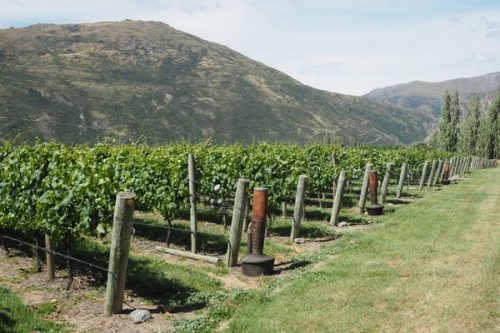
Dick Dunton, a heart surgeon from Dunedin, began what is now Rockburn when he planted a small vineyard in Lake Hayes back in 1991. He expanded this the following year by planting 10 hectares in Gibbston, and the winery was named Lake Hays. The core vineyard, 33 hectares in Pisa (called Parkburn) was added in 1996. The name was later changed to Rockburn, and these days there are two other co-owners as well as Dick.
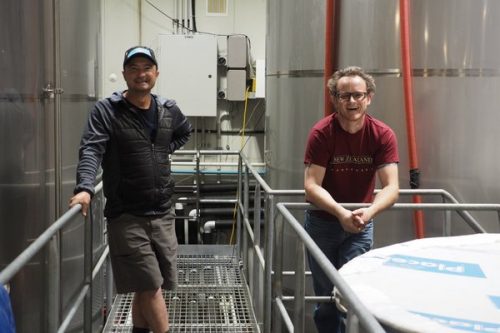
I visited with winemaker Malcolm Rees-Francis, who has been here since 2006, and assistant winemaker Scott Aliprandi. Before this, the wines were made by Rudi Bauer. They have a cellar door in Gibbston, but the wines are made in Cromwell.
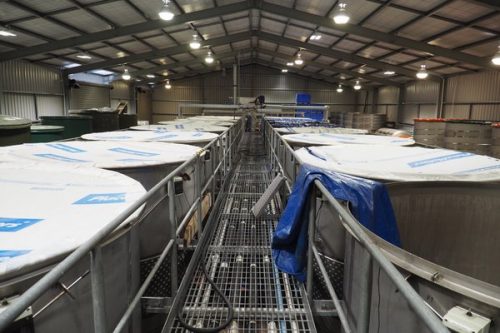
The winery is on the Ripponvale Road in Cromwell, and they’ve been here since 2016. It was originally a freezing works for sheep processing. At one time this was a big employer in the region, but it closed in the mid 1990s. It was first identified as a potential winery by the ill-fated McArthur Ridge outfit, which was supposed to be the biggest Pinot Noir vineyard development in the world. This ticked all the boxes for them. It was big enough to be a thousand ton winery (they had big plans), and it had town supply water and consent for putting trade waste into the town sewerage. So between 2006 and 2008 they bought it, gutted it and began converting it. But then along came the GFC, and they had no route to market, and the wheels came off. It changed hands a few more times until one of the Rockburn directors spotted it and they bought it.
As well as the grapes from their own 30 hectares of vines, they buy in 60% of their tonnage. ‘More and more of the fruit in Central Otago is spoken for,’ says Malcolm. ‘The spot market has dried up.’ He says that a lot of Pinot Noir from the region goes north to Marlborough. ‘We’re currently struggling to find enough fruit to satisfy what the market wants from us,’ he says. ‘If we could find another 50 tons of Pinot Noir and 20 tons of Pinot Gris we’d be happier. For Devil’s staircase we are sniffing around for Marlborough Pinot Noir, either to blend in 15% or to drop the Central Otago label and go South Island.’
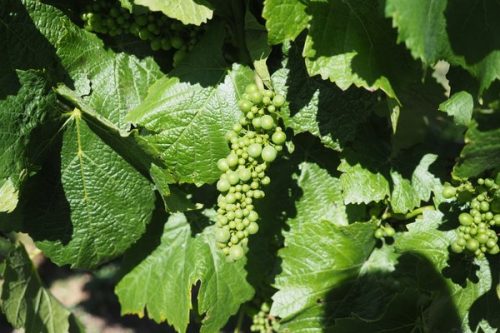
Malcolm first came to the region in 2000 and began working in the vineyards at Felton Road. He became assistant winemaker there in 2002, and in 2006 moved to Rockburn. ‘Initially I did everything by the numbers,’ he recalls. ‘I used enzymes and a lot of punchdowns. Now I use no enzymes and do less punching down.’ At Rockburn he doesn’t get the tannins he did at Felton Road, so leaves the wine on the skins for longer. ‘I leave it for three weeks at least or I just get a slightly obnoxious raspberry Pinot, and even if I put it in barrel for a year it just tastes of raspberries.’
He’s moved away from adding yeast. ‘When we moved out here I inoculated everything,’ he says. ‘I had no idea what might be out here.’ In 2018 he tried wild ferments with the Pinot Noirs for the first time, and they were fine.
Central Otago has an interesting situation with pH. The analysis at picking can be fine, but then during the Pinot Noir ferments it seems to be normal for the pH to rise significantly. This makes acid addition quite routine here, even among low-fi wine producers. ‘I don’t think nearly enough work has been done on our pH situation in Central Otago,’ says Malcolm. It doesn’t happen in every place around the world: it seems to be a particular problem in Central Otago.’
‘For the first couple of years I was very careful, but you get to learn a site and what you can get away with and what you can’t. I’m trying to be far more responsive to the terroir.’
The Parkburn Pinots have a pH in the high 3.7s, but the Gibbston ones are 3.6 without adjustment. Malcom is picking a bit earlier these days, and finds that you get fewer shifts in pH. ‘In the past it was live or die by pH 3.6, but I don’t worry so much about this any more. I’ve had some great Pinots at pH 3.8.’ He speculates that when you pick later there might be some translocation of potassium from the leaves into the fruit, which could cause the acid loss during fermentation.
The style of wines here is quite rich. ‘There seems to be a big demand for really big Pinot Noir out there,’ says Malcolm. I asked him whether he is meeting that demand: ‘I’m taking their money,’ he replied.
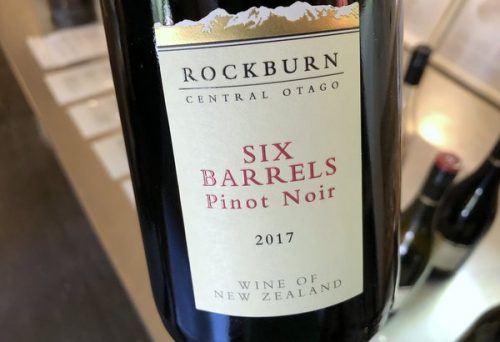
I tried some barrel samples from the 2018 Pinot Noir from the Parkburn vineyard. Malcolm says that Parkburn, an alluvial terrace left behind by a glacier, makes wines that can be too drinkable. ‘I have to try to make the wines more serious,’ he says.
- Clone 5 – this is direct, structured and really vivid with nice weight. It’s full flavoured, ripe, sweetly fruited and plush.
- Clone 6 – He did more extraction here, and 25% whole bunch. There are some sappy stemmy notes from the whole bunch, and sweet, silky, layered fruit. Nice finesse.
- Clone 115 – Direct, juicy and vivid with freshness and some stoniness. Has pure fruit.
- Clone Abel – Fresh, vivid and grippy with some spiciness. Bright and nicely structured with some brightness and some herby hints. Crunchy.
- Clone 667 and 115, in a Mercurey barrel – big with lots of fruit and some whole bunch character. Grippy and structural.
- Clone 10/5 – This always gets picked last. Rich and sweetly fruited. Bold and generous with some structure but also lush fruit. Opulent.
- Clones 5 & 6 from Gibbston – this is sappy and vivid with nice purity. Has supple fruit and some nice sour cherry.
Malcolm is keen on clone 10/5. He was previously at Felton Road, and got to work with it quite a bit with it there. He’s also fond of Abel. ‘We are planting it seriously,’ he says. ‘I like the potential of it.’ Abel gives good structure, and as Parkburn doesn’t give a lot of grip, he thinks Abel can help. He says that the Dijon clones tend to be pretty, but they don’t give him much more than that.
Rockburn Sauvignon Blanc 2016 Central Otago, New Zealand
Barrel fermented with wild yeasts. From Parkburn. Fresh and vivid with bright pear and apple fruit. Nicely focused and a bit crystalline. Good depth and intensity here. 90/100
Rockburn Fumé Blanc 2015 Central Otago, New Zealand
Spends 18 months in barrel, 10% new oak. Fig, pear and pea on the nose. Some grapefruit, too. There’s a nice concentration on the palate which shows a bit of spice. There’s a pea/green pepper edge to this wine. Intriguing. 89/100
Rockburn Pinot Gris 2016 Central Otago, New Zealand
From Gibbston. Lovely concentration and flavour intensity here with table grape, pear and spice notes. Fruity and inviting with just a hint of sweetness (4 g/litre) and a fine spicy finish. Lovely weight. 91/100
Rockburn Tigermoth Riesling 2015 Central Otago, New Zealand
From Parkburn. 67 g/l sugar. 10 g TA, pH 2.9. This is vivid and intense with the sweetness countering high levels of acidity. Juicy, citrussy and intense with nice sweetness. Direct and lemony with some melony richness. Very pure and direct. Lots of flavour here. 92/100
Rockburn Stolen Kiss Rosé 2018 Central Otago, New Zealand
Saignee method, taking 200-300 litres from each ferment. Rich and sweet (22 g/l sugar) with balancing freshness. Nice pale colour. Textured and direct with an approachable, seductive personality. 88/100
Rockburn Devil’s Staircase Blanc de Noir 2018 Central Otago, New Zealand
Fresh, dry and supple with nice focus, a hint of creaminess, and some lovey sappy, supple pear and cherry fruit. Very pale in colour, and nicely elegant. 90/100
Rockburn Pinot Noir 2017 Central Otago, New Zealand
Blend of both vineyards. Nicely intense with fresh, supple, sweet raspberry and cherry fruit. Juicy and direct with a nice crunch to the fruit. Has an ease to it, with good concentration but also some prettiness. Some nice sour cherry notes on the finish. 93/100
Rockburn Six Barrels Pinot Noir 2017 Central Otago, New Zealand
Gibbston, but this can change according to the year. Perfumed, floral nose with some sappy green hints and some tarry notes, as well as sweet cherry fruit. The palate is supple and silky with a sweet fruit core, some lushness, but also a fresh finish. Nice sour cherry and plum notes. Has freshness and elegance, as well as some opulence. I really like the floral notes. 94/100
Rockburn The Art Pinot Noir 2016 Central Otago, New Zealand
Small vineyard in Bannockburn, which they buy the grapes from. A bit more oak and 20% whole bunch. Cedary, savoury edge to the sweet red fruits nose. Fresh, linear and quite supple with a savoury streak to the palate. There’s some restraint to the fruit, and also some oak evident. A refined style that could age well. 92/100
Rockburn Devil’s Staircase Pinot Noir 2018 Central Otago, New Zealand
Tank fermented, bottled early. Floral, bright, sappy raspberry and red cherry fruit nose. Juicy, fresh, lively palate with approachable, crunchy berry fruits. It’s sweetly fruited and quite delicious with nice smashability. 89/100
Find these wines with wine-searcher.com
Leave a Comment on Central Otago (11) Rockburn